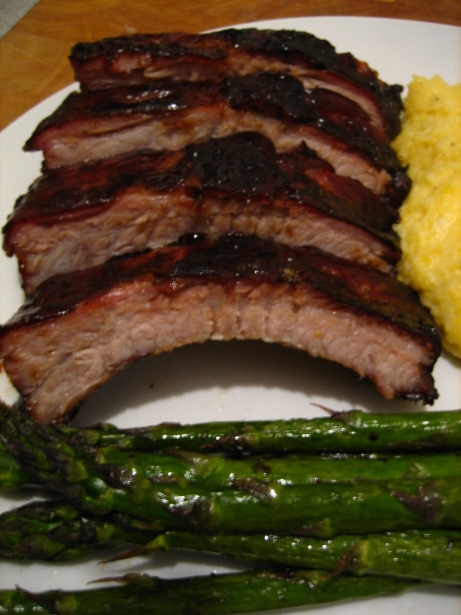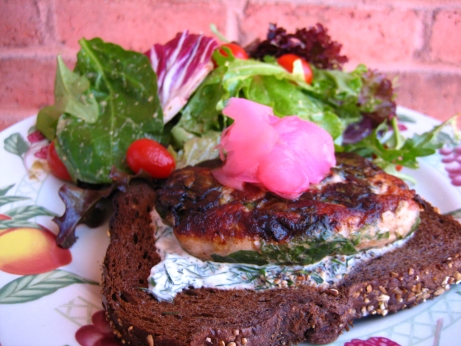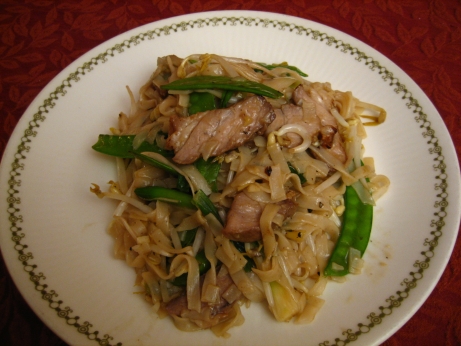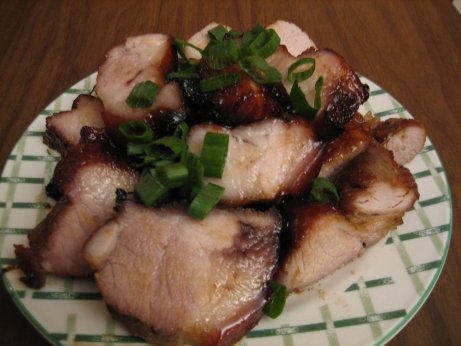
I wasn’t sure I was going to like these ribs, but I was pleasantly surprised. These are racks of ribs marinated in soy, sugar, ketchup, sherry, salt, garlic and ginger. They’re then baked at 325 for 1 3/4 hours, basting with the marinade every 20 minutes. Everything about the title is confusing, I get the Chinese part of the name, soy + ginger + garlic = Chinese, fine. But Hawaiian? Is it the ketchup that makes it Hawaiian? The blurb says the recipe came from a Hawaiian restaurant, but if they’d come from a Sweedish restaurant would they be Chinese-Sweedish ribs? Chinese-Hawaiian doesn’t really tell me a lot about what they’re going to taste like. “Barbecued” is another misnomer, quotation marks don’t turn barbecue into baking. Yes they’re low and slow, but where there’s no smoke there’s no barbecue.
I’m usually pretty relaxed about health and safety standards when I’m cooking. I’m happy to eat raw eggs, tartars and carpaccios, and if some leftovers have sat out longer than they should have I’m probably still going to eat them for lunch the next day. One aspect of this recipe gave me pause though. The ribs are marinated, then the marinade is used to baste the ribs while they’re in the oven. Using a marinade as a basting liquid or a glaze is often a delicious way of making the most of your marinade. Usually the marinade is brought to a boil before it does double duty as a glaze though. Not here, the only safety precaution the recipe mentions is to apply the last coating of glaze 10 minutes before you take it out of the oven. Maybe 10 minutes at 325 is enough to kill any nasties that have been growing in the raw meat juice marinade sitting out for nearly two hours… maybe. I followed the directions, and nothing bad happened. But it seems like bringing the marinade to a boil for a few minutes would make the whole operation a lot safer and not take a lot more effort.
The ribs themselves were surprisingly good. I was only able to marinade them for about 1 1/2 hours, instead of 3, but that didn’t seem to hurt anything. All the sugar in the marinade made for a thick caramelized coating, and the long cooking time almost gave them the falling off the bone tender texture of real barbecue. The glaze was thick enough to seal all the juices inside the ribs, so they stayed nice and moist. The glaze was a bit intense for my taste, it was really really salty and sweet. It could have used something to cut that. Normally some acid would be added to give the glaze some tang, or some chilies would spice things up. I find those flavours can balance the salty-sweet, whereas the ginger and garlic here weren’t really able to get the job done. I thought they were tasty, but too intense and unbalanced. My first few bites were delicious but after a couple of ribs it was getting to be too much.
I liked the baked and glazed ribs concept a lot. In future I would play around with the glaze, and try to keep the flavours in equilibrium. Low sodium soy might be an improvement, and cutting the sugar wouldn’t be a bad idea. The baking “barbecue” worked out well, it’s a pretty good substitute for those of use who don’t have a pit in the back yard. I’m still unclear how they were Hawaiian, but they were good.


